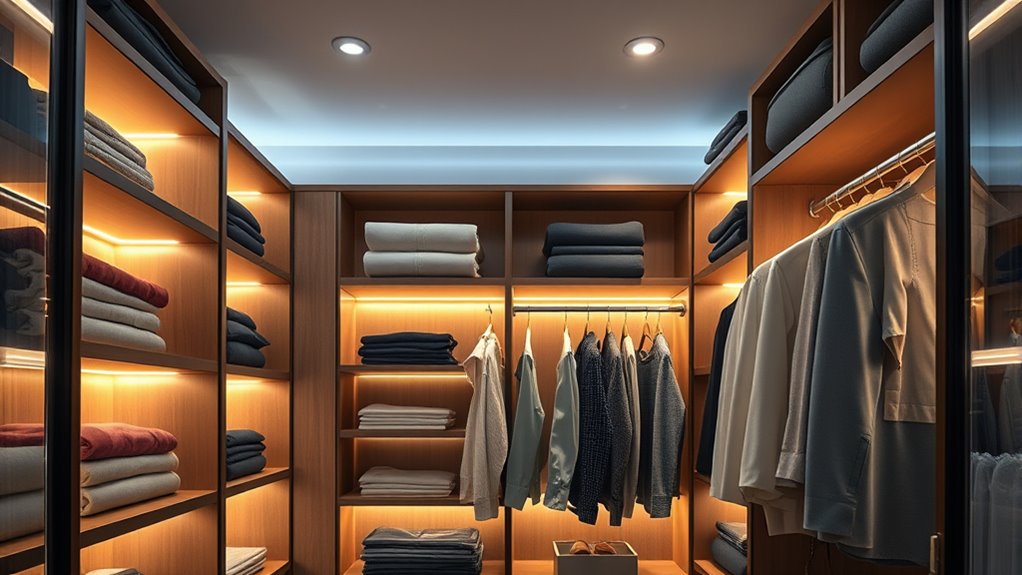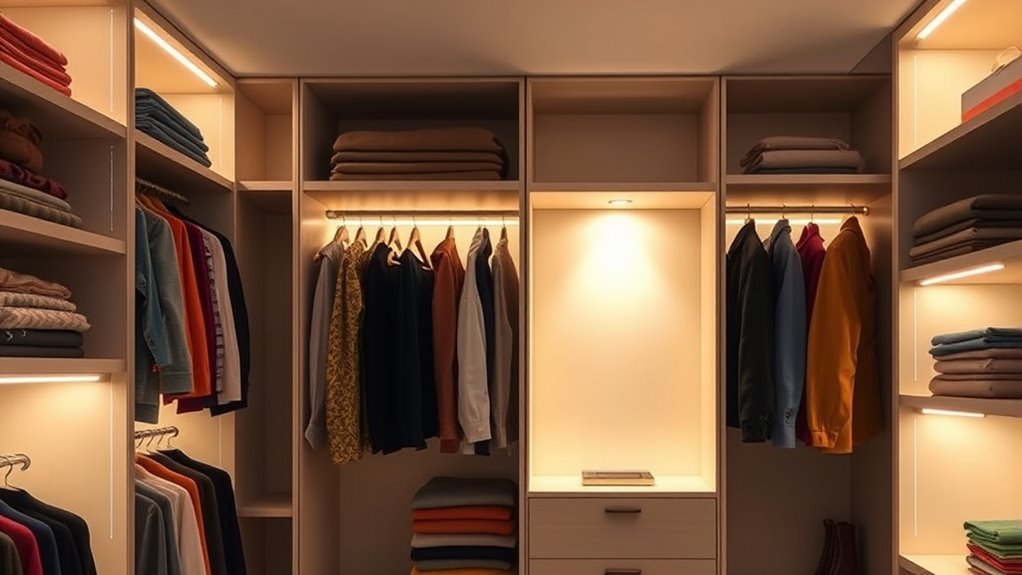To save energy with wardrobe lighting, install motion sensors near the door frame or inside the closet at eye level. Proper placement guarantees your lights turn on automatically when you open the door or reach inside, while preventing false triggers. Adjust sensor sensitivity and timeout settings for maximum efficiency. This setup lets you enjoy bright, automatic lighting without wasting electricity. Keep exploring to discover how strategic positioning makes your wardrobe lighting even smarter.
Key Takeaways
- Proper sensor placement near wardrobe doors ensures reliable detection and reduces false triggers.
- Mount sensors at eye level or slightly above for optimal movement detection and energy efficiency.
- Adjust sensitivity and timeout settings to minimize unnecessary lighting and maximize power savings.
- Position sensors to avoid obstructions and background activity that can cause false activations.
- Strategic placement enhances convenience, prevents light pollution, and optimizes overall energy consumption.

Installing wardrobe lighting with motion sensors is a smart way to make your daily routine more convenient and energy-efficient. When you set up these sensors properly, you can enjoy automatic lighting that turns on when you open your wardrobe and switches off when you close it. This eliminates the need to fumble for switches in the dark and ensures you’re not wasting energy leaving the lights on unnecessarily. The key to maximizing these benefits lies in sensor placement—the strategic positioning of sensors ensures reliable activation and deactivation, providing seamless illumination every time you access your wardrobe.
To optimize sensor placement, consider where you typically open your wardrobe. Mount the sensor near the door frame or inside the closet where it can clearly detect your movement. Avoid placing sensors where they might be obstructed or too far from the door, as this can lead to missed activations or false triggers. Positioning the sensor at a height that aligns with your natural movement, usually around eye level or slightly above, ensures it detects your presence without being overly sensitive to background activity. Proper placement not only guarantees consistent lighting but also helps in achieving significant energy savings by reducing unnecessary activation.
Energy savings become a direct benefit when you install your wardrobe lighting with the right sensor placement. Because the lights only turn on when needed, you avoid wasting electricity, which can add up over time. This is especially important if your wardrobe is large or frequently used, as it minimizes continuous power consumption. Additionally, modern motion sensors often come with adjustable sensitivity and timeout features, allowing you to fine-tune how long the light stays on after detecting movement. This customization further enhances energy efficiency, ensuring the light isn’t on longer than necessary. Proper sensor placement can also help in reducing light pollution within your home, creating a more comfortable living environment.
Frequently Asked Questions
How Long Do Motion Sensor Lights Typically Last Before Replacement?
Motion sensor lights usually last between 50,000 to 100,000 hours, depending on the bulb lifespan and sensor durability. You might find that LED bulbs, common in modern sensor lights, tend to last longer and are more reliable, often needing replacement after several years of regular use. Keep in mind that sensor durability can vary based on quality, so choosing high-quality fixtures helps guarantee your lights stay functional longer.
Are Motion Sensors Compatible With Existing Wardrobe Lighting Systems?
Think of your wardrobe lighting as a puzzle; adding a motion sensor is like fitting in a new piece. Usually, sensor compatibility depends on your current wiring integration. If your existing system uses standard wiring, you can often integrate sensors easily. However, some setups may require adapters or modifications. Check your wiring type and sensor specifications to guarantee seamless compatibility and avoid surprises, much like fitting puzzle pieces perfectly.
Can Motion Sensors Be Adjusted for Sensitivity and Delay Time?
You can definitely adjust motion sensors for sensitivity and delay time. Most models allow you to modify sensitivity adjustment, so the sensor responds appropriately to your movements. The delay time control lets you set how long the light stays on after you leave. By tweaking these settings, you guarantee the lighting is both energy-efficient and convenient, avoiding unnecessary on-off cycles and improving your wardrobe lighting experience.
What Are the Safety Considerations When Installing Sensor-Based Lighting?
Did you know that improper wiring causes over 45% of electrical fires? When installing sensor-based lighting, prioritize safety by guaranteeing proper wiring and secure connections to prevent fire hazards. Always follow electrical safety guidelines, use certified components, and consider professional installation. Regularly check sensors for damage or malfunction. These steps help protect your home from fire hazards and ensure your lighting system operates safely and efficiently.
Do Motion Sensor Lights Work Reliably in Low-Temperature Environments?
In cold climates, you might wonder if sensor accuracy affects motion sensor lights. Generally, they work reliably, but low temperatures can slow down the sensors or cause false triggers. To guarantee proper function, choose lights designed for cold environments and install them correctly. Regularly check and maintain your sensors, especially during winter, to keep your lighting system dependable and responsive despite the chill.
Conclusion
Think of your wardrobe as a secret garden, hidden away and waiting to be revealed. With motion sensor lighting, you turn the key effortlessly, illuminating your space only when needed. This not only saves energy but also keeps your wardrobe neat and accessible at all times. Embrace this smart upgrade, and let your wardrobe glow like a well-kept treasure chest—bright, efficient, and always ready when you open the door.








